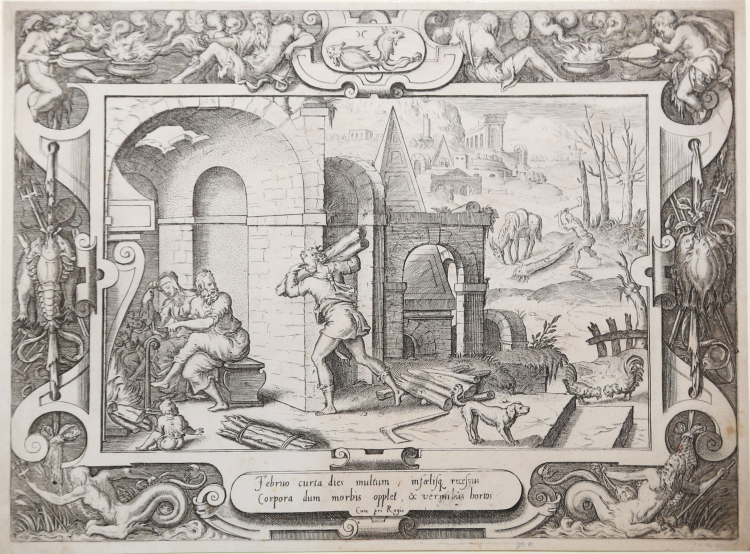




| Reference: | S12585 |
| Author | Etienne DELAUNE |
| Year: | 1570 ca. |
| Measures: | 234 x 175 mm |



| Reference: | S12585 |
| Author | Etienne DELAUNE |
| Year: | 1570 ca. |
| Measures: | 234 x 175 mm |
Engraving, 1570 circa, lettered at the bottom "Februo curta dies multum.. Vermibus hortos" Cum pri Regis.
From "The Labours of the Months", a set of twelve scenes representing seasonal activities, each of them within heavily decorated square frame.
This series of twelve plates bears a royal privilege and thus was most likely executed before Delaune's departure from France following the massacre on St Bartholomew's Day (1572).
Also see related series of anonymous woodcuts derived from Delaune's prints, E,9.163-174.
Robert-Dumesnil also records a series of copies by Johann Bussemacher.
|
Robert-Dumesnil n. 137; 'The French Prints in Renaissance', Los Angeles 1994, cat. No.106-9; and 'Fontainebleau et l'estampe au XVIe siècle, iconographie et contradictions', Nemours 1985, cat. Nos.11, 30, 70, 141.
|
Etienne DELAUNE (Parigi, 1519 circa; Parigi, 1583)
|
French goldsmith, medallist, draughtsman and engraver. He was recorded as a journeyman goldsmith in Paris in 1546 and was appointed to the royal mint in January 1552. He was, however, removed in June that year. A number of medals, including one of Henry II (Paris, Bib. N., Cab. Médailles), are attributed to him. He did not become an engraver until about 1557; his first dated prints, a series of 12 plates illustrating the Old Testament and two designs for hand mirrors, were made in 1561. He found his models in the work of such Italian artists of the FONTAINEBLEAU SCHOOL as Rosso Fiorentino, Nicolò dell’Abate and especially Luca Penni, rather than in that of Francesco Primaticcio. The year 1569 seems to have marked the peak of Delaune’s Fontainebleau production, with about ten prints inspired by the Italian masters. As a Calvinist he left Paris at the time of the St Bartholomew’s Eve massacre on 24 August 1572 and took refuge in Strasbourg, a free city of the Holy Roman Empire. He stayed there for four months, then obtained commissions to make ‘portraits’ elsewhere, probably in Augsburg, where in 1576 he made two engravings depicting a goldsmith’s workshop. He was in Strasbourg again the following year and was still there in 1580, the date of his suite of 20 engravings of moral allegories based on drawings by his son Jean Delaune (c. 1580). His last dated engraving, a portrait of Ambroise Paré, dates from 1582.
|
|
Robert-Dumesnil n. 137; 'The French Prints in Renaissance', Los Angeles 1994, cat. No.106-9; and 'Fontainebleau et l'estampe au XVIe siècle, iconographie et contradictions', Nemours 1985, cat. Nos.11, 30, 70, 141.
|
Etienne DELAUNE (Parigi, 1519 circa; Parigi, 1583)
|
French goldsmith, medallist, draughtsman and engraver. He was recorded as a journeyman goldsmith in Paris in 1546 and was appointed to the royal mint in January 1552. He was, however, removed in June that year. A number of medals, including one of Henry II (Paris, Bib. N., Cab. Médailles), are attributed to him. He did not become an engraver until about 1557; his first dated prints, a series of 12 plates illustrating the Old Testament and two designs for hand mirrors, were made in 1561. He found his models in the work of such Italian artists of the FONTAINEBLEAU SCHOOL as Rosso Fiorentino, Nicolò dell’Abate and especially Luca Penni, rather than in that of Francesco Primaticcio. The year 1569 seems to have marked the peak of Delaune’s Fontainebleau production, with about ten prints inspired by the Italian masters. As a Calvinist he left Paris at the time of the St Bartholomew’s Eve massacre on 24 August 1572 and took refuge in Strasbourg, a free city of the Holy Roman Empire. He stayed there for four months, then obtained commissions to make ‘portraits’ elsewhere, probably in Augsburg, where in 1576 he made two engravings depicting a goldsmith’s workshop. He was in Strasbourg again the following year and was still there in 1580, the date of his suite of 20 engravings of moral allegories based on drawings by his son Jean Delaune (c. 1580). His last dated engraving, a portrait of Ambroise Paré, dates from 1582.
|